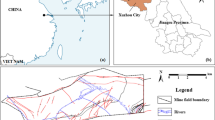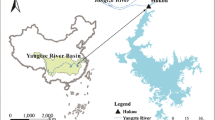Abstract
The quality of mine water samples from Hongliulin, Shaanxi Province, China was comprehensively evaluated. The inorganic fraction was analyzed by an analytic hierarchy process, while the main types of dissolved organic matter (DOM) were identified and quantified using fluorescence regional integration. Of the eight samples evaluated, those collected from surface water as well as one coal roof water sample (from the no. 52 seam) were classified as type I. These samples had much lower fluorescence integral values than their counterparts. One water sample from the no. 42 coal face and one from the no. 52 coal haulage roadway were type V, with much higher fluorescence integral values. All of the other water samples evaluated were classified as type II, with intermediate fluorescence integral values. This study showed that sedimentation can improve water quality from type II to type I, allowing it to be safely used for both human consumption and agricultural production. This strategy also reduced DOM by 37.17%.
Zusammenfassung
Die Qualität von Grubenwasserproben aus Hongliulin in der chinesischen Shaanxi Provinz wurden umfassend untersucht. Die anorganische Fraktion wurde mittels analytischem Hierarchieprozess analysiert, während die Hauptarten an gelöster organischer Substanz mittels Fluorescence Regional Integration (FRI) identifiziert und quantifiziert wurden. Von den acht untersuchten Proben wurden diejenigen, die aus Oberflächengewässern stammten sowie eine aus dem Hangenden (aus dem 52er Flöz) als Typ I klassifiziert. Diese Proben hatten weitaus geringere Fluoreszenz-Integrationswerte als die übrigen Proben. Jeweils eine Probe aus dem 42er Kohlenstoß und der 52er Kohleförderstraße mit deutlich höheren Fluoreszenz-Integrationswerten waren Typ V. Alle weiteren untersuchten Proben mit dazwischenliegenden Fluoreszenz-Integrationswerten wurden als Typ II klassifiziert. Die Untersuchung zeigt, dass die Wasserqualität durch Sedimentation von Typ II auf Typ I verbessert werden kann, wodurch das Wasser für menschlichen Gebrauch und landwirtschaftliche Zwecke verwendet werden kann. Auf diese Weise werden die Fluoreszenz-Integrationswerte der Proben von 1.177 auf 739, also um 37,17 %, reduziert.
Resumen
La calidad de las muestras de agua de la mina de Hongliulin, provincia de Shaanxi, China, se evaluó exhaustivamente. La fracción inorgánica se analizó mediante un proceso de jerarquía analítica, mientras que los principales tipos de materia orgánica disuelta (DOM) fueron identificados y cuantificados mediante integración local de fluorescencia. De las ocho muestras evaluadas, las recolectadas de aguas superficiales y una muestra de agua del techo de carbón (de la veta nº 52) se clasificaron como tipo I. Estas muestras tenían valores integrales de fluorescencia mucho más bajos que sus contrapartes. Una muestra de agua de la cara de trabajo nº 42 y una de la ruta de transporte de carbón nº 52 fueron del tipo V, con valores integrales de fluorescencia mucho más altos. Todas las otras muestras de agua evaluadas se clasificaron como tipo II, con valores integrales de fluorescencia intermedia. Este estudio demostró que el tratamiento de sedimentación puede usarse para mejorar la calidad del agua del tipo II al tipo I, lo que permite su uso seguro tanto para el consumo humano como para la producción agrícola. Esta estrategia también reduce los valores integrales de fluorescencia de muestras de 1177 a 739, una reducción de 37,17% del DOM.
层次模糊理论和荧光区域积分法评价矿井水水质
综合评价了中国陕西红柳林矿井水水质。层次分析法分析矿井水非有机部分而荧光区域积分法识别和定量评价矿井水可溶有机物质(DOM)。在八个水样中,地表水和一个煤矿顶板(第52煤)水样归类为类型I,水样拥有更低荧光积分值。第42工作面和第52煤运输大巷水样归类为类型V,水样荧光积分值较高。所有其它水样归类为类型II,荧光积分值中等。研究显示,沉淀处理可提高水质从类型II提高至类型I,适于人类饮用和农业利用。该处理使水样的荧光积分值从1,177降至739,可溶有机物质(DOM)减少37.17%。





Similar content being viewed by others
References
Al-Reasi HA, Usman YD, Scott SD, Wood CM (2013) The effect of dissolved organic matter (DOM) on sodium transport and nitrogenous waste excretion of the freshwater cladoceran (Daphnia magna) at circumneutral and low pH. Comp Biochem Phys C 158:207–215
Ashwani KT, Prasoon KS, Mukesh KM (2016) Environmental geochemistry and a quality assessment of mine water in the West Bokaro Coalfield, India. Mine Water Environ 35(4):525–535
Chen W, Westerhoff P, Leenheer JA, Booksh K (2003) Fluorescence excitation-emission matrix regional integration to quantify spectra for dissolved organic matter. Environ Sci Technol 37(24):5701–5710
Da Y, Cheuk MM (2017) An assessment model of classroom acoustical environment based on fuzzy comprehensive evaluation method. Appl Acoust 127(12):292–296
Du YH, Wei KP, Liu EH (2017) Gray prediction model of water quality based on clustering and fusion. Desalin Water Treat 64(2):48–53
Fu JX, Chen Z, Ma XG, Shang T, Zhang W, Cao XY (2011) Application of improved fuzzy comprehensive evaluation method in water quality assessment. Environ Eng 29(6):120–123 (in Chinese, with English abstract)
General Administration of Quality Supervision, Inspection and Quarantine of the People’s Republic of China (2017) GB/T 14848 Quality Standard for Groundwater (in Chinese)
Guo L, Zhang L, Hu CJ, Lei JF (2014) Status analysis and measures taken for mine water management in China. J Chin Coal Soc 39(S2): 484–489 (in Chinese, with English abstract)
Hambly ACE, Arvin LF, Pedersen PB, Pedersen B. Seredyńska-Sobecka CA. Stedmon (2015) Charactering organic matter in recirculating aquaculture systems with fluorescence EEM spectroscopy. Water Resour 83:112–120
Han L, Song Y, Duan L, Peng Y (2015) Risk assessment methodology for Shenyang Chemical Industrial Park based on fuzzy comprehensive evaluation. Environ Earth Sci 73(9):5185–5192
Henderson RK, Baker A, Murphy KR, Hambly A, Stuetz RM, Khan SJ (2009) Fluorescence as a potential monitoring tool for recycled water systems: a review. Water Resour 43(4):863–881
Li XL, Wang LG, Zhao K, Liu L (2009) Improvement and application of fuzzy comprehensive evaluation method for mine water quality. J Water Resour Water Eng 20(5):5–8 (in Chinese, with English abstract)
Liu XL, Wang SY (2012) Mine water inrush forecasting during the mining under waters. Disaster Adv 5(4):876–881
Liu HL, Lu LS, Sun JW (2017) Manufacture of high-quality chopped carbon fibers based on fuzzy comprehensive evaluation. Adv Mech Eng 9(6):1–12
Mohammad RM, Reza S, Ahmad M, Kooshiar AV, Sharareh L, Sogol O, Mehrnoosh A, Azita M (2013) Assessment of water quality in groundwater resources of Iran using a modified drinking water quality index. Ecol Indic 30:28–34
Patricio XP, Souhail RA, David AB, Barbara AB, Ronald BL, Samantha JS (2016) Bench-scale and pilot-scale treatment technologies for the removal of total dissolved solids from coal mine water: a review. Mine Water Environ 35:94–112
Singh KK, Mahato MK, Neogi B (2010) Quality assessment of mine water in the Raniganj coalfield area, India. Mine Water Environ 29(4):248–262
Singh AP, Chakrabarti S, Kumar S (2017) Assessment of air quality in the Haora River basin using fuzzy multiple-attribute decision making techniques. Environ Monit Assess 189(8):373
Wang XY, Wang TT, Wang Q, Li RZ (2016a) Evaluation of floor water inrush based on fractal theory and an improved analytic hierarchy process. Mine Water Environ 36:87–95
Wang XY, Zhen XG, Li RZ, Liu XM, Wang TT, Zhao L, Yang J (2016b) Migration and transformation characteristics of DOM in fine sand and marl rock. Water Sci Technol 74(1):157–164
Wei Y, Zhang JS, Chen QH (2011) Application of the gray clustering method to water quality evaluation in the mining sector of the Min Jiang River. Safe Environ Eng 18(5):53–56 (in Chinese, with English abstract)
Xie QM, Xia YY (2004) A multi-objective decision-making method for the treatment scheme of landslide hazard. J Univ Sci Technol Beijing 11:101–105
Xue X, Yang X (2014) Seismic liquefaction potential assessed by fuzzy comprehensive evaluation method. Nat Hazards 71(3):2101–2112
Yang J, Jin DW (2015) Variation characteristics of dissolved organic matter in underground mine water with combined water treatment process at surface and underground mine. J Chin Coal Soc 40(2):439–444 (in Chinese, with English abstract)
Yang J, Wang X (2015) Fluorescence feature of dissolved organic matter in the groundwater of mining area—the vertical difference of the aquifers. J Safe Environ 15(5):44–47 (in Chinese, with English abstract)
Acknowledgements
This work was supported by National Key Research and Development Plan (Grant 2016YFC0501104) and the National Natural Science Foundation of China (Grant 41302214).
Author information
Authors and Affiliations
Corresponding author
Rights and permissions
About this article
Cite this article
Liu, Y., Wang, T. & Yang, J. Evaluating the Quality of Mine Water Using Hierarchical Fuzzy Theory and Fluorescence Regional Integration. Mine Water Environ 38, 243–251 (2019). https://doi.org/10.1007/s10230-018-0567-4
Received:
Accepted:
Published:
Issue Date:
DOI: https://doi.org/10.1007/s10230-018-0567-4




